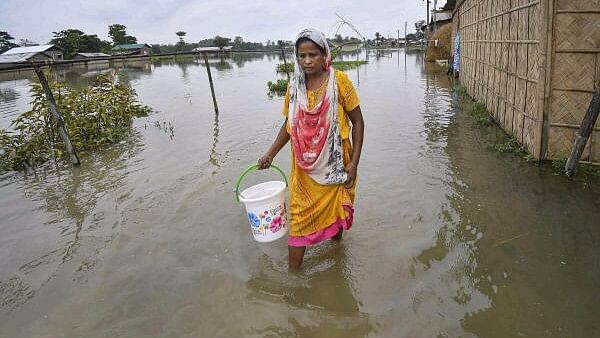
A woman walks through a flood-affected area, in Nagaon district of Assam.
Credit: PTI Photo
Guwahati: Assam reported seven new deaths due to floods in the past 24-hours, taking the death toll in the deluge this year to 79.
The daily flood bulletin issued by Assam State Disaster Management Authority (ASDMA) on Tuesday evening said that two deaths were reported from Cachar district in South Assam while one death was reported each from Dhubri, South Salmara, Dhemaji, Nagaon and Sivasagar district.
The bulletin said that more than 17.17 lakh people in 26 out of 34 districts remained affected while Barpeta, Cachar, Golaghat, Sivasagar and Nagaon were the worst hit districts. More than 48,000 people were provided shelter in 507 relief camps. Crop area of 39,870 hectares has been destroyed due to the flood so far, said the bulletin.
The river Brahmaputra was flowing above the danger level at Nematighat (Jorhat), Tezpur (Sonitpur), Guwahati and Dhubri while several of its tributaries also crossed the danger mark.
Nine rhinos, 150 other animals killed in Kaziranga
The famous Kaziranga National Park (KNP) in Assam, the world's biggest habitat for one-horned rhinos, has lost nine prized rhinos in the ongoing floods that have wreaked havoc across the state.
Director of the park Sonali Ghosh said in a report on Tuesday that carcasses of three one-horned rhinos were found in the past 24-hours taking the number of rhino deaths to nine so far. Two rhinos were rescued.
A total of 159 wild animals including 130 hog deers died in the flood water in the past two weeks. Two more hog deers died after being hit by vehicles while crossing the highway passing through the park. Ghosh said in a report that 108 hog deers were treated and released. Out of the 233 forest camps, 62 still remained inundated and the forest personnel were forced to vacate four of them due to the rise in water.
As the flood inundates their habitats, animals rush to the hills of Karbi Anglong district on the other side of the highway but many are killed in vehicle hits despite having the speed limits clamped by the administration.
The 1,090 square kilometer Kaziranga has 2,600 one-horned rhinos and many die due to the flood that hits the national park almost every Monsoon. The death of the animals have become a worry but conservationists said that flood is necessary to keep the park's ecology and the animal life cycle going on.
"Kaziranga is a young ecological habitat with predominantly wet alluvial grassland and wetland complex. Floods bring humus and silt and replenish the habitat, reduce and arrest natural succession. Flood also removes sanile and weaker individuals in a wild population, ensuring genetic health and vigour. Without floods the natural succession, drainage of the 94 permanent and other temporary wetlands is also affected. Fish and other aquatic flora and fauna is greatly benefitted by such floods which is a key biodiversity element in Kaziranga complex," Bhaskar Choudhury, WildlIfe Trust of India's head of wild rescue division and project head of the Centre for Wildlife Rehabilitation and Conservation at Kaziranga, told DH on Tuesday.